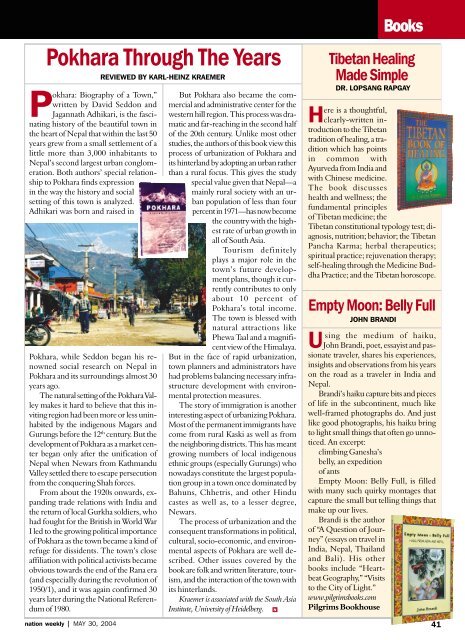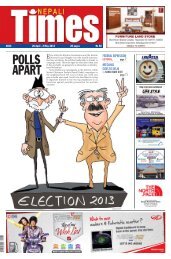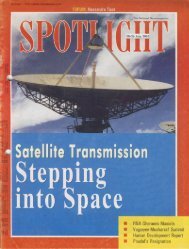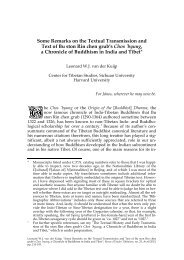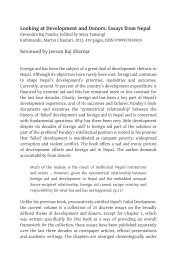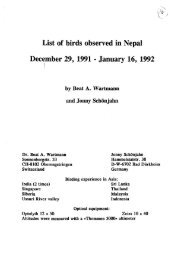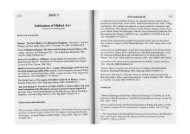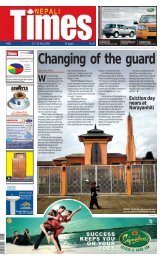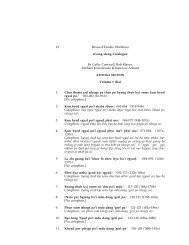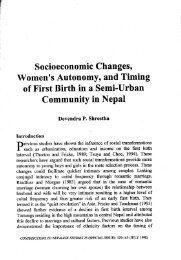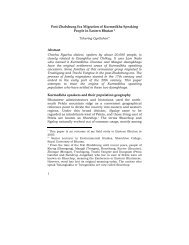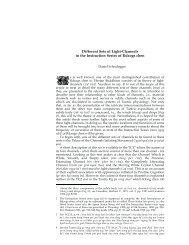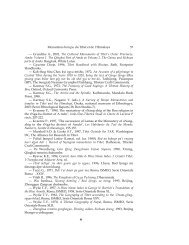You also want an ePaper? Increase the reach of your titles
YUMPU automatically turns print PDFs into web optimized ePapers that Google loves.
Pokhara Through The Years<br />
Pokhara: Biography of a Town,”<br />
written by David Seddon and<br />
Jagannath Adhikari, is the fascinating<br />
history of the beautiful town in<br />
the heart of Nepal that within the last 50<br />
years grew from a small settlement of a<br />
little more than 3,000 inhabitants to<br />
Nepal’s second largest urban conglomeration.<br />
Both authors’ special relationship<br />
to Pokhara finds expression<br />
in the way the history and social<br />
setting of this town is analyzed.<br />
Adhikari was born and raised in<br />
Pokhara, while Seddon began his renowned<br />
social research on Nepal in<br />
Pokhara and its surroundings almost 30<br />
years ago.<br />
The natural setting of the Pokhara Valley<br />
makes it hard to believe that this inviting<br />
region had been more or less uninhabited<br />
by the indigenous Magars and<br />
Gurungs before the 12 th century. But the<br />
development of Pokhara as a market center<br />
began only after the unification of<br />
Nepal when Newars from Kathmandu<br />
Valley settled there to escape persecution<br />
from the conquering Shah forces.<br />
From about the 1920s onwards, expanding<br />
trade relations with India and<br />
the return of local Gurkha soldiers, who<br />
had fought for the British in World War<br />
I led to the growing political importance<br />
of Pokhara as the town became a kind of<br />
refuge for dissidents. The town’s close<br />
affiliation with political activists became<br />
obvious towards the end of the Rana era<br />
(and especially during the revolution of<br />
1950/1), and it was again confirmed 30<br />
years later during the <strong>Nation</strong>al Referendum<br />
of 1980.<br />
nation weekly | MAY 30, 2004<br />
REVIEWED BY KARL-HEINZ KRAEMER<br />
But Pokhara also became the commercial<br />
and administrative center for the<br />
western hill region. This process was dramatic<br />
and far-reaching in the second half<br />
of the 20th century. Unlike most other<br />
studies, the authors of this book view this<br />
process of urbanization of Pokhara and<br />
its hinterland by adopting an urban rather<br />
than a rural focus. This gives the study<br />
special value given that Nepal—a<br />
mainly rural society with an urban<br />
population of less than four<br />
percent in 1971—has now become<br />
the country with the highest<br />
rate of urban growth in<br />
all of South Asia.<br />
Tourism definitely<br />
plays a major role in the<br />
town’s future development<br />
plans, though it currently<br />
contributes to only<br />
about 10 percent of<br />
Pokhara’s total income.<br />
tc.uws.edu<br />
The town is blessed with<br />
natural attractions like<br />
Phewa Taal and a magnificent<br />
view of the Himalaya.<br />
But in the face of rapid urbanization,<br />
town planners and administrators have<br />
had problems balancing necessary infrastructure<br />
development with environmental<br />
protection measures.<br />
The story of immigration is another<br />
interesting aspect of urbanizing Pokhara.<br />
Most of the permanent immigrants have<br />
come from rural Kaski as well as from<br />
the neighboring districts. N This has meant<br />
growing numbers of local indigenous<br />
ethnic groups (especially Gurungs) who<br />
nowadays constitute the largest population<br />
group in a town once dominated by<br />
Bahuns, Chhetris, and other Hindu<br />
castes as well as, to a lesser degree,<br />
Newars.<br />
The process of urbanization and the<br />
consequent transformations in political,<br />
cultural, socio-economic, and environmental<br />
aspects of Pokhara are well described.<br />
Other issues covered by the<br />
book are folk and written literature, tourism,<br />
and the interaction of the town with<br />
its hinterlands.<br />
Kraemer is associated with the South Asia<br />
Institute, University of Heidelberg.<br />
Books<br />
Tibetan Healing<br />
Made Simple<br />
DR. LOPSANG RAPGAY<br />
H ere is a thoughtful,<br />
clearly-written introduction<br />
to the Tibetan<br />
tradition of healing, a tradition<br />
which has points<br />
in common with<br />
Ayurveda from India and<br />
with Chinese medicine.<br />
The book discusses<br />
health and wellness; the<br />
fundamental principles<br />
of Tibetan medicine; the<br />
Tibetan constitutional typology test; diagnosis,<br />
nutrition; behavior; the Tibetan<br />
Pancha Karma; herbal therapeutics;<br />
spiritual practice; rejuvenation therapy;<br />
self-healing through the Medicine Buddha<br />
Practice; and the Tibetan horoscope.<br />
Empty Moon: Belly Full<br />
JOHN BRANDI<br />
Using the medium of haiku,<br />
John Brandi, poet, essayist and passionate<br />
traveler, shares his experiences,<br />
insights and observations from his years<br />
on the road as a traveler in India and<br />
Nepal.<br />
Brandi’s haiku capture bits and pieces<br />
of life in the subcontinent, much like<br />
well-framed photographs do. And just<br />
like good photographs, his haiku bring<br />
to light small things that often go unnoticed.<br />
An excerpt:<br />
climbing Ganesha’s<br />
belly, an expedition<br />
of ants<br />
Empty Moon: Belly Full, is filled<br />
with many such quirky montages that<br />
capture the small but telling things that<br />
make up our lives.<br />
Brandi is the author<br />
of “A Question of Journey”<br />
(essays on travel in<br />
India, Nepal, Thailand<br />
and Bali). His other<br />
books include “Heartbeat<br />
Geography,” “Visits<br />
to the City of Light.”<br />
www.pilgrimsbooks.com<br />
Pilgrims Bookhouse<br />
41


